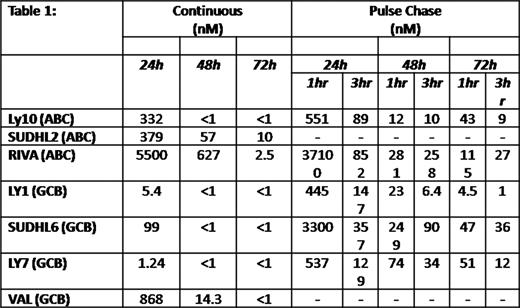Abstract
Abstract 118
A mitotic spindle target that has emerged as unique and potentially restricted to the mitotic spindle is Eg5, also known as the kinesin spindle protein (KSP). SB-743921 induces mitotic spindle dysfunction and cell cycle arrest by inhibiting Eg5. Preliminary Phase 1 studies of SB-743921 have demonstrated that this compound is not associated with any neuropathy like other anti-mitotic agents. These studies have also demonstrated a potential signal in patients with relapsed and refractory lymphoma. We investigated the efficacy of SB-743921 in aggressive B-cell lymphomas to evaluate effectiveness and tolerability in germinal center (GCB) and post germinal center (ABC) diffuse large B-cell lymphomas (DLBCL). For cytotoxicity assays, luminescent cell viability was performed using CellTiter-Glo™ followed by acquisition with Biotek Synergy HT. The IC50s were calculated using the Calcusyn software (Biosoft). Cell Cycle was assessed by staining with Vybrant DyeCycle Green (Invitrogen) followed by FACSCalibur acquisition. Whole cell lysate proteins were extracted and quantified according to Bradford assay. After electrophoresis on a gradient 4–20% SDS-PAGE gels the proteins were transferred to nitrocellulose membrane. After blocking and incubation with the primary and the secondary antibodies, the chemiluminescent agent was added and the x-ray films were exposed to the membranes. In vivo experiments were performed with five to 7-week-old severe combined immunodeficiency (SCID) beige mice (Taconic Laboratories, Germantown, NY) injected with 1 × 107 Ly1-DLBCL cells on the flank via a subcutaneous (SQ) route. When tumor volumes approached 80 mm3, mice were separated into cohorts of ten mice each. Tumors were assessed using the two largest perpendicular axes (l, length; w, width) as measured with standard calipers. Tumor volume was calculated using the formula 4/3 r3, where r=(l + w) / 4. Tumor-bearing mice were assessed for weight loss and tumor volume at least twice weekly. The IC50 values for SB-743921 across a panel of different DLBCL lines are listed in table 1.
Cell cycle analysis showed that compared to the untreated group, after treatment with 100nM of SB 743921 the percentage of GCB cells in G2/M phase increased from 17.6% to 40.3% (+129%) in Ly7, 23.9% to 40.7 % (+70%) in Sudhl6 and from 17.55% to 32.4% (+85%) in Ly1. In comparison, the percent increase of cells in G2/M for the ABC lines was statistically less (p-value 0.001). For example, Ly10 increased from 15% to 27.6% (+45%), Riva from 29.3% to 36.95% (+26%) and Sudhl2 from 22.6% to 27.6% (+22%). Immunoblot analysis of DLBCL cells treated with SB-743921 probed for Eg5, CyclinB1, and phosphorylated BubR1 revealed that although all cells demonstrated a measurable increase in Eg5, the total Eg5 present varied from cell line to cell line. The In vivo xenograft experiment was conducted with the GCB Ly1 cell line and consisted of 4 cohorts; one control and 3 treatments with doses of 2.5 mg/kg, 5 mg/kg and 10 mg/kg. SB-743921 was administered by the intraperitoneal route on days 1, 5, and 9 on a 23 day cycle for 2 cycles. The graph below displays the inhibition of tumor growth in the cohorts after treatment with SB-74321. All 3 cohorts had a p-value of <0.001 relative to the control.
In conclusion, SB-743921 is promising as a single agent for treatment of DLBCL. Future studies exploring the specific cell cycle features of different cell lines with respect to their check-point control will afford new opportunities to better understand the mechanisms of increased resistance in ABC compared to GCB. The data suggests SB 743921 overall is effective in the treatment of DLBCL both in vitro and in vivo. Further studies exploring potential synergistic interactions with conventional chemotherapeutic agents as well as establishing the most effective treatment schedules for the agent may provide a new approach to treating these diseases.
Escandon:Cytokinetics: Employment. Wood:Cytokinetics: Employment. O'Connor:Millennium Pharmaceuticals, Inc.: Membership on an entity's Board of Directors or advisory committees, Research Funding.
Author notes
Asterisk with author names denotes non-ASH members.



